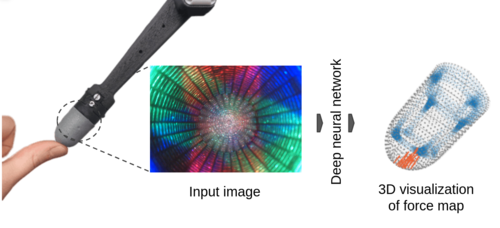2024
2022
Richardson, B. A., Kuchenbecker, K. J., Martius, G.
A Sequential Group VAE for Robot Learning of Haptic Representations
pages: 1-11, Workshop paper (8 pages) presented at the CoRL Workshop on Aligning Robot Representations with Humans, Auckland, New Zealand, December 2022 (misc)
Andrussow, I., Sun, H., Kuchenbecker, K. J., Martius, G.
A Soft Vision-Based Tactile Sensor for Robotic Fingertip Manipulation
Workshop paper (1 page) presented at the IROS Workshop on Large-Scale Robotic Skin: Perception, Interaction and Control, Kyoto, Japan, October 2022 (misc)
Sun, H.
Machine-Learning-Driven Haptic Sensor Design
University of Tuebingen, Library, 2022 (phdthesis)
2021
Werner, M., Junginger, A., Hennig, P., Martius, G.
Informed Equation Learning
arXiv, 2021 (misc)
2016
Martius, G., Lampert, C. H.
Extrapolation and learning equations
2016, arXiv preprint 1610.02995 (misc)
2014
Martius, G., Der, R., Herrmann, J. M.
Robot Learning by Guided Self-Organization
In Guided Self-Organization: Inception, 9, pages: 223-260, Emergence, Complexity and Computation, Springer Berlin Heidelberg, 2014 (incollection)
2013
Der, R., Martius, G.
Behavior as broken symmetry in embodied self-organizing robots
In Advances in Artificial Life, ECAL 2013, pages: 601-608, MIT Press, 2013 (incollection)
2011
Martius, G., Herrmann, J. M.
Tipping the Scales: Guidance and Intrinsically Motivated Behavior
In Advances in Artificial Life, ECAL 2011, pages: 506-513, (Editors: Tom Lenaerts and Mario Giacobini and Hugues Bersini and Paul Bourgine and Marco Dorigo and René Doursat), MIT Press, 2011 (incollection)
2010
Martius, G.
Goal-Oriented Control of Self-Organizing Behavior in Autonomous Robots
Georg-August-Universität Göttingen, 2010 (phdthesis)
Martius, G., Hesse, F., Güttler, F., Der, R.
\textscLpzRobots: A free and powerful robot simulator
\urlhttp://robot.informatik.uni-leipzig.de/software, 2010 (misc)
Der, R., Martius, G.
Playful Machines: Tutorial
\urlhttp://robot.informatik.uni-leipzig.de/tutorial?lang=en, 2010 (misc)
Martius, G., Herrmann, J. M.
Taming the Beast: Guided Self-organization of Behavior in Autonomous Robots
In From Animals to Animats 11, 6226, pages: 50-61, LNCS, Springer, 2010 (incollection)


